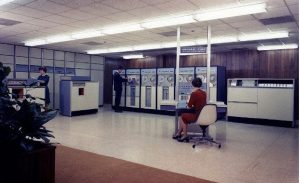History (1962): Univac 1107 Thin-Film Memory Computer Announced
First one
This is a Press Release edited by StorageNewsletter.com on May 28, 2018 at 2:07 pmThis article comes from the Computer History Museum.
1962: Thin-film memory commercially available
Univac 1107 Thin-Film Memory computer announced
Sperry Rand UNIVAC 1107 computer (ca. 1962)

(Courtesy of the Hagley Museum and Library © Unisys Corporation)
In the early 1960s thin film memory arrays offered significantly faster performance than mainstream magnetic core technology. Vacuum-deposited dots of ferromagnetic alloy material on glass substrates were overlaid with a multilayer grid of connecting wires that served as drive and sense lines similar to those of a magnetic core array.
Sperry Rand developed the technology under a National Security Agency contract and announced its commercial availability in the Univac 1107 Thin-Film Memory Computer in 1962. In this application a 128-word thin-film general register stack achieved a cycle time of 600 nanoseconds compared to 4 microseconds of the 16,384 36-bit word main memory.
The Univac design and others by RCA and Hughes also served in airborne computer applications.
In 1968, IBM announced the formal acceptance of two System/360 Model 95 super-speed computers. Equipped with ‘ultra-high-speed thin-film memories, the Model 95 incorporated ‘over a million characters (bytes) of information stored on magnetic spots four millionths of an inch thick’ in a cache memory that worked together with four megabytes of core. With an access time of 67 nanoseconds, this was claimed to be the fastest, large-scale memory in user operation. This same machine also employed IBM’s first monolithic integrated circuit (IC) memory, the SP95 16-bit, system-protect array.
IBM built a new plant at Essex Junction near Burlington, VT, to fabricate thin-film memory devices. When semiconductor technology surpassed the performance and cost of thin-film, the facility was converted to high volume manufacturing of ICs. The company’s investment in thin-film research paid dividends in 1979 when the technology was adapted to produce head structures for the IBM Model 3370 disk drive, replacing heads based on solid ferrite technology.














 Subscribe to our free daily newsletter
Subscribe to our free daily newsletter

